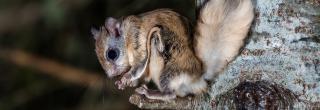 |
| Fact Sheet |
| Scientific Name |
Glaucomys sabrinus |
| Description |
Flying squirrels do not fly, but glide from one perch to another. Their "flight" is made possible by a fold of skin, a membrane which extends from the front to the hind feet. When the legs are outstretched, the skin stretches out tautly to form a large planing surface which enables the squirrel to glide as far as 150 feet, though most glides are between 20 and 30 feet. Flying squirrels are noted for their dense fur, glossy olive-brown above and white below, large brown eyes, and mild disposition. Only the shrews and moles have fur that comes close in softness and silkiness to that of flying squirrels. |
| Total Length |
Measures almost 11 inches, including the wide flattened tail which is nearly half as long as the flying squirrel |
| Weight |
2 - 3 ounces |
| Color |
The upper parts are gray-brown, whereas all the lower parts including the tail are white. |
| Reproduction |
Females of mate in early spring, and about five weeks later, give birth to three to five tiny, blind young. |
| Food |
Flying squirrels eat a variety of fruits and nuts, insects, small birds, and meat scraps. Flying squirrels are frequent visitors at bird feeders, and some people have lights at the feeders so they can watch the flying squirrel's antics at night. |
| Predators |
Small hawks and owls, foxes, weasels, marten |
| Habitat and Range |
Living in tree hollows or leaf nests, flying squirrels are the only nocturnal squirrels in North Dakota. Seldom will you see them. |


